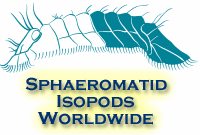| Abstract |
In this study, a molecular phylogenetic hypothesis for 16 species of serolid isopods (Crustacea, Isopoda, Serolidae) from Antarctic waters, the deep sea, South America, and Australia is presented. The genes used are a 500-bp fragment of the mitochondrial LSU rRNA gene and a 700-bp fragment located in the variable region V4 of the nuclear SSU rRNA gene, The species composition and monophyly of morphologically defined genera of which several members were available are confirmed by the molecular data (Ceratoserolis, Spinoserolis, and Cuspidoserolis). The molecular data also support the redefinition of Frontoserolis s.l.
and Serolella and the erection of the new genera Septemserolis and Paraserolis, as proposed by Wagele. The relationship among several genera is resolved differently in the molecular hypothesis than in the two existing morphological hypotheses, however. The molecular phylogeny may have important consequences for understanding the biogeography of the Serolidae, indicating that all Antarctic species in this study form a monophyletic group which has probably derived from species with closest extant relatives in South America. All 3 species included in this study living today in deep waters (>2000 m) of the Southern Ocean are most
closely related to species living on the Antarctic shelf, so that parallel colonization of the deep sea by way of polar submergence can be reconstructed. In this study, a V4 expansion segment is reported which exceeds the longest crustacean sequences known until now by more than 270 bp, Although the V4 expansion segment has proven useful for phylogenetic purposes in this study, there is circumstantial evidence that its mechanism of evolution may depend not only on inheritance of single-site substitutions, making its routine use in phylogenetic studies potentially dangerous. |

















